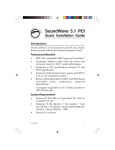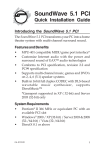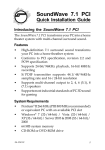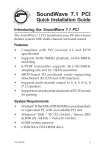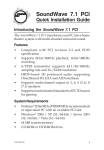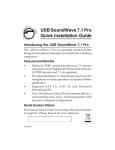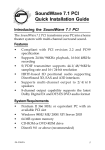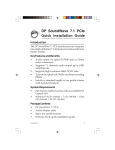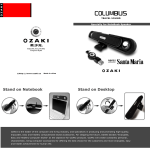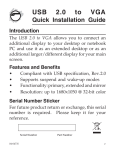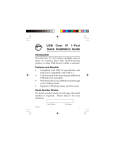Download SIIG DP SoundWave 4 Channel PCI Installation guide
Transcript
DP SoundWave 4 Channel PCI Quick Installation Guide Introduction The DP SoundWave 4 Channel PCI is a high performance multimedia sound card which takes full advantage of the PCI bus architecture, while maintaining compatibility with legacy software. Features and Benefits • • • • • • Full-duplex playback and recording Built-in 16-bit CODEC Built-in 32 OHM earphone buffer Supports multi-channel output to 2 or 4 speaker systems 4 Channel 16-bit DAC ACPI compliant power down management System Requirements • • • Pentium®II 266 MHz (PIII 800 MHz recommended) or equivalent PC with an available PCI slot Windows® 8 (32-/64-bit) / 7 (32-/64-bit) / Vista (32-/64-bit) / XP (32-bit/64-bit) / Server 2003 & 2008 (32-/64-bit) / Server 2008 R2 / 2000 64MB system memory or above 04-0517E 1 Package Contents • • • • DP SoundWave 4 Channel PCI Spare low profile bracket Software CD (Xear 3D) Quick installation guide Layout Line In Mic In Aux-In Analog CD-In Front Speaker Rear Speaker Figure 1: Layout Note: You can connect to both CD-In and Aux-In at the same time. However, only one CD-In can be connected at one time. • • • 2 Line In: This connector provides line-in function. Supports analog stereo playback only. Mic In: This connector provides microphone-in function. Front Speaker: This connector provides front source output, you can connect one set of active speakers, headphones or audio-in of home stereo. • • • Rear Speaker: This connector provides rear sound - four channel speakers mode must be enabled. Analog CD-In (J1 and J2 internal): This connector can be used to attach CD-ROM or DVD-ROM audio cable. There are two different connectors. Select the connector that matches your audio cable. Only one connector can be connected at one time. Aux In (internal): This connector can be used to connect other audio output devices. Hardware Installation Note: For low profile systems, replace the currently mounted bracket with the included low profile bracket. It is recommended that you remove any previously installed sound card drivers before installing the DP SoundWave 4 Channel PCI to avoid any conflicts. If previously installed drivers are not removed, the DP SoundWave 4 Channel PCI may not function properly. General instructions for installing the card are provided below. Since the design of computer cases and motherboards vary, refer to your computer’ s reference manual for further information, if needed. Static Electricity Discharge may permanently damage your system. Discharge any static electricity build up in your body by touching your computer case for a few seconds. Avoid any contact with internal parts and handle cards only by their external edges. 1. 2. 3. 4. Turn OFF the power to your computer and any other connected peripheral devices. Unplug the power cord from the back of the computer. Remove your computer’ s cover. Remove the slot bracket from an available PCI slot. 3 5. 6. 7. To install the card, carefully align the card's bus connector with the selected PCI slot on the motherboard. Push the board down firmly, but gently, until it is well seated. Replace the slot bracket holding screw to secure the card. Connect one end of the audio cable from your CD-ROM or DVD-player to the CD In on the soundcard, then replace the computer cover and reconnect the power cord. Driver Installation Follow the instructions below to install the DP SoundWave 4 Channel PCI drivers. Windows 8 (32-/64-bit) 1. 2. 3. 4. Install the board then boot up Windows. At the Windows desktop, insert the Software CD. Click Windows key and R, type D:\setup.exe, click OK. (Change D: to match your CD-ROM drive letter) Follow the on-screen instructions to complete the installation. Windows 7 (32-/64-bit) / Server 2008 R2 1. 2. 3. 4. 4 Install the board then boot up Windows. At the Windows desktop, insert the Software CD. Close the CD autoplay box if prompted. Click Start, in the Search programs and files box, type D:\setup.exe, press Enter. (Change D: to match your CD-ROM drive letter) Follow the on-screen instructions to complete the installation. Windows Vista (32-/64-bit) / Server 2008 (32-/64bit) 1. 2. 3. 4. 5. Install the board then boot up Windows. At the Found New Hardware window, click Cancel. Insert the Software CD: At the AutoPlay window: Click Open folder to view files. Double click Setup. If AutoPlay doesn't start: Click Start, in the Start Search box, type D:\setup.exe, press Enter. (Change D: to match your CD-ROM drive letter) Click Allow. Skip this step if not prompted. Select Yes, I want to restart my computer now, then click Finish. Windows XP (32-/64-bit) / Server 2003 (32-/64bit) / 2000 1. 2. 3. 4. 5. 6. Install the board then boot up in Windows. At the Found New Hardware Wizard, click Cancel. Insert the Software CD. Close the CD autoplay box if prompted. Click Start, Run, type D:\setup.exe, then click OK. (Change D: to match your CD-ROM drive letter) Click Next two times. Select Yes, I want to restart my computer now, then click Finish. 5 To Verify Windows Installation 1. 2. 3. Check Device Manager to verify installation. For Windows 8 / 7 / XP / Server 2003 & 2008 R2: Right click Computer or My Computer, click Manage, click Device Manager. For Windows Vista: Right click Computer, click Manage, click Continue, click Device Manager. For Windows Server 2008: Right click Computer, click Manage, double click Diagnostics, click Device Manager. Double-click Sound, video and game controllers, then double click C-Media PCI Audio Device. A message This device is working properly is displayed, the driver has been correctly installed. Uninstalling the Sound Card Driver Windows 8 / 7 / Server 2008 R2 1. 2. 3. Click Start, Control Panel, then click Programs. Double click Uninstall a Program under Programs. Double click C-Media PCI Audio Device, select Yes, I want to restart my computer now, then follow on-screen instructions to uninstall the driver. Windows Vista 1. 2. 3. 6 Click Start, then Control Panel. Double click Uninstall a Program under Programs. Double click C-Media PCI Audio Device, click Continue. Follow on-screen instructions to uninstall the driver. Windows XP / Server 2003 / 2000 1. 2. 3. 4. Click Start, Settings, then Control Panel. Double click Add/Remove Programs. Select C-Media PCI Audio, then click Change/Remove or Add/Remove button. Follow the on-screen instructions to uninstall the driver. Windows Server 2008 1. 2. 3. 4. Click Start, then Control Panel. Double click Programs and Features. Double click C-Media PCI Audio. Select Yes, I want to restart my computer now, then click Finish to restart Windows. Speaker Configuration Note: For Server 2008 and 2008 R2, the speaker might be disabled after driver installation. To enable the speaker, right click the volumn control icon in the task bar, click Sound, click Yes then click OK. Windows 8 / 7 / Server 2008 R2 Make sure to log in as Administrator or an account with administrative privileges. 1. Right click the volume control icon located in the taskbar by the system clock. 2. Click Playback devices, select C-Media PCI Audio Device, click Configure. 3. Follow the on-screen instructions to configure your speakers. 7 Windows Vista Make sure to log in as Administrator or an account with administrative privileges. 1. Right click the volume control icon located in the taskbar by the system clock. 2. Click Playback devices, select C-Media PCI Audio Device, click Configure. 3. Follow the on-screen instructions to configure your speakers. Windows XP / Server 2003 / 2000 1. 2. 3. 4. 5. From the main desktop, click Start, Settings, Control Panel. Click Sounds and Multimedia, select Audio tab. Click Advanced under Sound Playback, then click the Speakers tab. Click the drop down arrow and select your speakers. Click Apply, then OK to save the settings. Windows Server 2008 Make sure to log in as Administrator or an account with administrative privileges. 1. Right click the volume control icon located in the taskbar by the system clock. If prompted, click Yes to enable Windows Audio Service, otherwise continue to step 2. 2. Click Playback , select C-Media PCI Audio Device, click Configure. 3. Follow on-screen instructions to setup your speakers. 8 Utilities Software Xear 3D is an audio setup utility for your soundcard. Xear 3D quick start icon, located in the system tray by the clock, installs automatically during driver installation. In addition to configuring speaker type, sound effects and listening environment, the utility includes mixer and equalizer software. Simply click on the quick start icon to open the audio setup utility. Note: In Xear 3D, please select four speakers under Analog Output to get the full 4 channel capability. 9 Blank Page 10 Technical Support and Warranty QUESTIONS? SIIG’ s Online Support has answers! Simply visit our web site at www.siig.com and click Support. Our online support database is updated daily with new drivers and solutions. Answers to your questions could be just a few clicks away. You can also submit questions online and a technical support analyst will promptly respond. SIIG offers a 5-year manufacturer warranty with this product. This warranty covers the original purchaser and guarantees the product to be free of any defects in materials or workmanship for five (5) years from the date of purchase of the product. SIIG will, at our discretion, repair or replace (with an identical product or product having similar features and functionality) the product if defective in materials or workmanship. This warranty gives you specific legal rights, and you may also have other rights which vary from state to state. Please see our web site for more warranty details. If you encounter any problems with this product, please follow the procedures below. A) If it is within the store's return policy period, please return the product to the store where you purchased it. B) If your purchase has passed the store's return policy period, please follow these steps to have the product repaired or replaced. Step 1: Submit your RMA request. Go to www.siig.com, click Support, then Request A Product Replacement to submit a request to SIIG RMA or fax a request to 510-657-5962. Your RMA request will be processed, if the product is determined to be defective, an RMA number will be issued. Step 2: After obtaining an RMA number, ship the product. • Properly pack the product for shipping. All software, cable(s) and any other accessories that came with the original package must be included. • Clearly write your RMA number on the top of the returned package. SIIG will refuse to accept any shipping package, and will not be responsible for a product returned without an RMA number posted on the outside of the shipping carton. • You are responsible for the cost of shipping to SIIG. Ship the product to the following address: SIIG, Inc. 6078 Stewart Avenue Fremont, CA 94538-3152, USA RMA #: • SIIG will ship the repaired or replaced product via Ground in the U.S. and International Economy outside of the U.S. at no cost to the customer. 11 About SIIG, Inc. Founded in 1985, SIIG, Inc. is a leading manufacturer of IT connectivity solutions (including Serial ATA and Ultra ATA Controllers, FireWire, USB, and legacy I/O adapters) that bridge the connection between Desktop/Notebook systems and external peripherals. SIIG continues to grow by adding A/V and Digital Signage connectivity solutions to our extensive portfolio. All centered around the distribution and switching of A/V signals over CAT5/6, these products include matrix switches, distribution amplifiers, extenders, converters, splitters, cabling, and more. SIIG is the premier one-stop source of upgrades and is committed to providing high quality products while keeping economical and competitive prices. High-quality control standards are evident by one of the lowest defective return rates in the industry. Our products offer comprehensive user manuals, user-friendly features, and most products are backed by a lifetime warranty. SIIG products can be found in many computer retail stores, mail order catalogs, and e-commerce sites in the Americas, as well as through major distributors, system integrators, and VARs. PRODUCT NAME DP SoundWave 4 Channel PCI FCC RULES: TESTED TO COMPLY WITH FCC PART 15, CLASS B OPERATING ENVIRONMENT: FOR HOME OR OFFICE USE FCC COMPLIANCE STATEMENT: This device complies with part 15 of the FCC Rules. Operation is subject to the following two conditions: (1) This device may not cause harmful interference, and (2) this device must accept any interference received, including interference that may cause undesired operation. THE PARTY RESPONSIBLE FOR PRODUCT COMPLIANCE SIIG, Inc. 6078 Stewart Avenue Fremont, CA 94538-3152, USA Phone: 510-657-8688 DP SoundWave 4 Channel PCI is a trademark of SIIG, Inc. SIIG and the SIIG logo are registered trademarks of SIIG, Inc. Microsoft and Windows are registered trademarks of Microsoft Corporation. All other names used in this publication are for identification only and may be trademarks of their respective owners. December, 2012 Copyright © 2012 by SIIG, Inc. All rights reserved.












